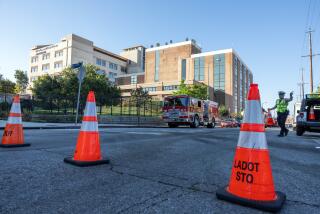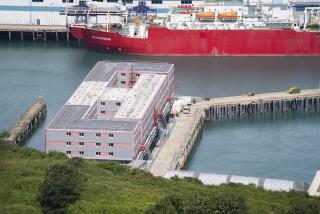Hospital Cooling System Focus of Legionnaires’ Inquiry
- Share via
An investigation into the source of three recent cases of legionnaires’ disease at the City of Hope Medical Center in Duarte is focusing on an aging cooling system that was “contaminated” with standing water, rust and dirt, the federal Centers for Disease Control official directing the investigation said Wednesday. Such conditions often are breeding grounds for the bacteria that cause the illness.
The cooling system, on the roof of one of the hospital buildings, was “an area where routine maintenance had been neglected,” according to Dr. Peter W. Kerndt, a Los Angeles-based CDC investigator who is attached to the county health department.
Dr. Ralph Jung, the hospital’s acting medical director, said all of the air-conditioning systems, including the suspect one, are “routinely maintained.” He said any conclusion should await definitive laboratory results.
The system, since decontaminated, had ventilated the nursing station and the corridors in the City of Hope’s bone marrow transplant unit, where the three recent legionnaires’ cases developed, as well as some offices on another floor in the same building, Kerndt said.
The 11 patient rooms on the bone marrow unit have a total of four separate cooling systems; the air conditioner for one of these rooms was contaminated by standing water.
Kerndt said the large cooling system, which is more than 20 years old, “was the worst (of the cooling systems) by far and a likely source.”
He found an inch of standing water and sediment beneath the air-conditioning unit when he obtained water samples to be cultured for bacteria.
“The system pulled in air and dirt from the outside,” Kerndt said. “Part of the bottom was rusted through. There were drip pans to collect the water, which condensed on the cooling coils.”
Kerndt said it was likely that the Legionella bacteria would be isolated from the system. But the physician added that special tests to determine the sub-type of the bacteria would be necessary to see if the system was linked to the cases of legionnaires’ pneumonia. This is because the organism is frequently isolated from water systems unrelated to human disease.
Also on Wednesday, a City of Hope physician said patient care at the hospital is back to normal. The two wards that were evacuated have been decontaminated and the patients were returned to their rooms on Monday.
The three cases of legionnaires’ pneumonia developed in mid-August, in leukemia patients who had bone marrow transplants earlier in the month. Two of the patients are doing well, and the third, who also suffers from an unrelated life-threatening illness, remains in an intensive care unit, according to Dr. Stephen J. Forman, the assistant director of the bone marrow transplant unit. No additional cases have developed, he said.
One case of legionnaires’ was diagnosed at the nationally known medical center in March and two in June. All three patients died, two as a result of other infections and the third as a result of multiple causes despite treatment for legionnaires’ disease.
One of those patients, diagnosed in June, developed the infection at another hospital before being transferred to the City of Hope, Kerndt said. Investigators are still uncertain if the other two cases are linked to the August outbreak.
More to Read
Sign up for Essential California
The most important California stories and recommendations in your inbox every morning.
You may occasionally receive promotional content from the Los Angeles Times.













